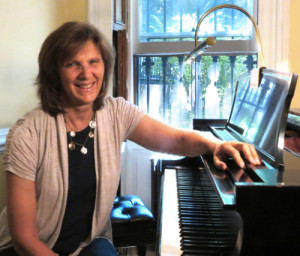Are you looking for a piano teacher in Park Slope?
Fiona Bicket is an experienced piano teacher in jazz and classical piano styles with an excellent reputation. Her studio is within easy walking distance of many schools in Park Slope, Brooklyn, New York. She is also conveniently located to mass transit.
- Jazz and classical music styles.
- Lessons in improvising, both melodic improvisation and keyboard harmony.
- Private piano lessons for all ages.
- Piano teacher in Park Slope, Brooklyn, for over 20 years.
- Lessons available in the New York City area.
- Performance opportunities and recitals for students on a regular basis.
- Live classical or jazz piano performances for parties or special events.
- Piano accompaniment for classical or jazz vocalists.
Contact Fiona Bicket by email at fbicket@gmail.com.

Qualifications and Professional Piano Study
Associate Diplomas in Classical and Jazz Studies from the Australian Music Examinations Board and New South Wales Conservatorium of Music.
Intensive study with several of New York’s finest teachers and musicians, including:
What is it that gives us this deep wish to express ourselves through music?
by Fiona Bicket
Some say it’s likely that early man gave voice to song before uttering the spoken word. And it is true that an infant’s first vocalizations are often song-like and rhythmic.
When a new student comes to me for his or her first lesson, this mysterious element of motivation is not far from my mind. What is it that inspired this student to want to learn the piano? What do they hope to discover and develop through the process of learning the piano?
More than once I’ve heard that a young child, when asked if they would like to take piano lessons, has responded “But I already know how to play the piano!” In a way, they are right. They do already have the wish, the rhythmic impetus, to make a joyful noise. Just give them a piano, a drum, or a rattle, and they will express themselves in a free and uninhibited way.
Of course, this expression, though sometimes quite beautiful, is limited by a lack of familiarity with our musical language- a language which, at its best, refines and gives meaning and direction to an otherwise rough outpouring.
Unfortunately, the process of learning this language and acquiring the technique to learn an instrument can be a trap: the original vibrant wish to make music can be buried under an avalanche of difficulties with sight reading, theoretical facts, and repetitive technical exercises. After a while, the student could be forgiven for wondering why they ever embarked on this difficult journey.
For me, as a piano teacher, this raises an important question: How can I introduce a student to the necessary musical materials and at the same time allow that student to follow their heart? It is with this in mind that I have, over several decades, chosen a variety of methods and materials which are flexible enough to engender a sense of freedom, and broad enough to allow each student to embark on their own journey of discovery. Whether they are improvising, or playing classical pieces, or blues, or harmonizing folk songs by ear, my wish is that each student will feel empowered to express themselves fully and freely.
—FB